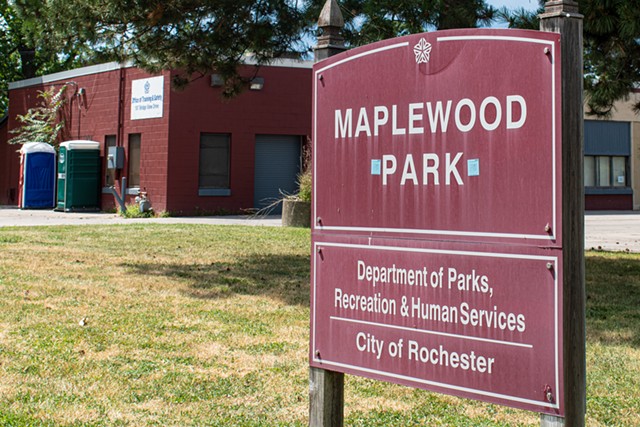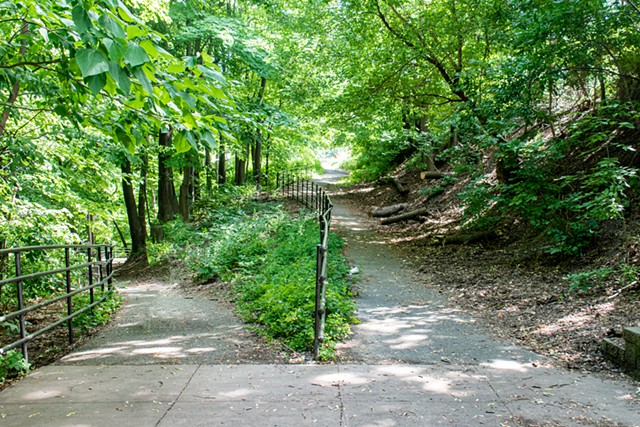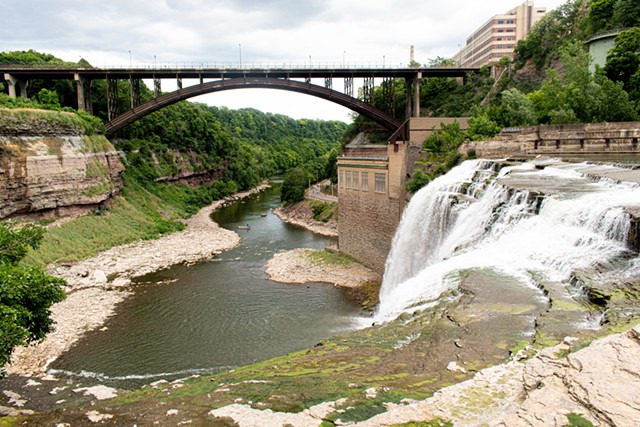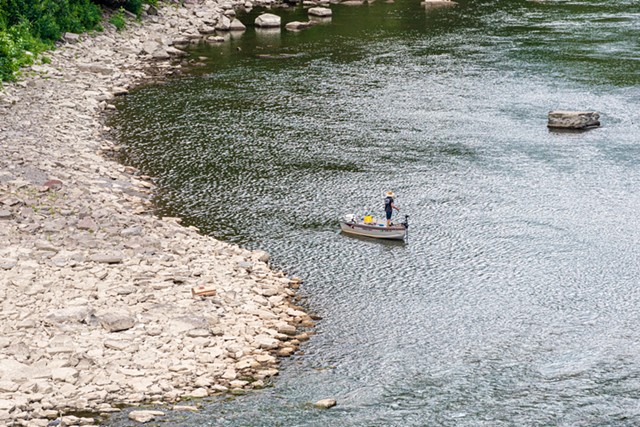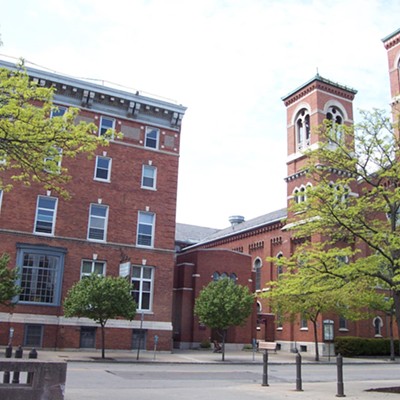[
{
"name": "500x250 Ad",
"insertPoint": "5",
"component": "15667920",
"parentWrapperClass": "",
"requiredCountToDisplay": "1"
}
]
A modest, rectangular building sits at the northern end of Maplewood Park, a two-mile stretch of meandering trails and greenspace along the western banks of the Genesee River.
At present, it is marked with a sign that reads “Maplewood Training Center,” although it has had past lives as a recreation center and a police station. In fact, the building still houses police motorcycles.
But the city has set in motion a $5.5 million plan to breathe new life into Maplewood Park — and that building. As part of that project, the easy-to-miss structure will become the Maplewood Nature Center, which the city intends to be an entry point to the park and a community gathering space.
“The vision for it is to have it definitely be a space geared towards our nature programming but also have it be a space,” said Sara Scott, the city of Rochester’s coordinator of horticultural and environmental programming. “So we’re envisioning the inside as open to the public with a classroom space, a kitchen space, with the ability for groups to rent it out.”
If the project remains on its current schedule, the city expects design work on the Nature Center to conclude in 2024, and the renovations to wrap up in 2026.
YEARS IN THE MAKING
The Maplewood Nature Center project is currently in its design stage, as the city solicits firms to flesh out a vision for improving the building, its parking lot, and a nearby playground. But the concept is years in the making.
In 2019, the city released a document outlining potential amenities for Maplewood Park. Among the possibilities were canopies of solar panels installed over parking spots, a preschool classroom, a kitchen for public use, and a renovated playground inspired by woods and nature.
A fresh injection of federal COVID-19 relief funds made the vision a reality. Rochester received $202.1 million through the American Rescue Plan Act and that funding will cover almost the entirety of the nature center’s price tag, or $5.3 million of the $5.5 million project. The project fell under the act’s criteria of “investments in communities to promote improved health outcomes and public safety.”
At a July meeting of the Maplewood Neighborhood Association, members said the renovation of the park was long overdue and that it should be done in a way that makes the park easily accessible to residents of the community.
“For it to be connected to the neighborhood, the city is going to need to deliberately connect it,” said Bill Collins, who serves on the association’s board. “Not only to the neighborhood, but for people that want to go there that don’t have cars. Right now, it’s difficult to go there if you don’t have a car, it’s difficult to walk to.”
In April 2021, the Rochester City Council unanimously adopted a Children’s Outdoor Bill of Rights, a document developed by the National League of Cities that underscores the notion that urban youngsters should have easy access to nature.
“The mayor and City Council are committed to ensuring all children in Rochester have access to nature and experience the benefits of spending time outside,” the bill of rights reads.
The Children’s Outdoor Bill of Rights articulates one of the driving principles behind the Maplewood Nature Center project, Scott said.
“I certainly feel that the work is guided by the ideas of equity and inclusion, especially of our youth and our families,” Scott said. “And specifically serving the youth in the city that may not have the ability to get outside of the city and frequent a park or get out on the water.”
The city also wants to make sure Maplewood Park connects with some of the other revitalization projects happening through the ROC the Riverway initiative, such as the planned High Falls state park directly to the south.
AN OLMSTED VISION
JoAnn Beck has lived in the Maplewood Neighborhood for decades, and was once the city’s senior landscape architect. She had a hand in sculpting projects like Martin Luther King Memorial Park at Manhattan Square and Lower Falls Park, which sits directly at the southern end of Maplewood.
She sees the development of the nature center as long overdue.
“(The building) has been a police station, it’s been a training center, it’s about time it’s been put back into park use,” Beck said. “I am thrilled that there’s going to be investment into this gorgeous, beautiful, neglected landscape.”
Beck also chairs the Landmark Society of Western New York’s sub-committee on Olmsted Parks. The visionary landscape architect Frederick Law Olmsted designed Maplewood Park, as well as the city’s Seneca Park, Genesee Valley Park, and Highland Park. Seneca Park connects to Maplewood via a footbridge spanning the river.
Olmsted’s vision for the parks was clear — to create public spaces that embrace existing natural features and where people are able to convene with, rather than impede on, nature.
“It is very desirable that the woods on the banks of the river below the park be preserved as they stand at present,” an 1891 Democrat & Chronicle article quoted him as saying. “...The land is certainly of no use for industrial purposes, nor for any purposes that I can think of. The board would do well to provide for the preservation of the trees.”
Angelo Calieri, a member of the Maplewood Neighborhood Association, said the project, if done right, would be in the spirit of Olmsted’s original intentions for the park.
“Olmsted’s philosophy on parks is bring the parks to the people,” Calieri said. “You don’t put parks where people have to go find them.”
Olmsted was an early conservationist who believed parks should be natural oases where city dwellers can find serenity. Scott believes the work being done at Maplewood is a testament to those ideals.
“Honestly, it’s an Olmsted space, and I feel in some ways it’s returning it to the vision of what Olmsted and others in our city felt the park should be — a public asset that is about having an oasis, having access to nature in the midst of the city,” Scott said.
Gino Fanelli is a CITY staff writer. He can be reached at (585) 775-9692 or [email protected].
At present, it is marked with a sign that reads “Maplewood Training Center,” although it has had past lives as a recreation center and a police station. In fact, the building still houses police motorcycles.
But the city has set in motion a $5.5 million plan to breathe new life into Maplewood Park — and that building. As part of that project, the easy-to-miss structure will become the Maplewood Nature Center, which the city intends to be an entry point to the park and a community gathering space.
“The vision for it is to have it definitely be a space geared towards our nature programming but also have it be a space,” said Sara Scott, the city of Rochester’s coordinator of horticultural and environmental programming. “So we’re envisioning the inside as open to the public with a classroom space, a kitchen space, with the ability for groups to rent it out.”
If the project remains on its current schedule, the city expects design work on the Nature Center to conclude in 2024, and the renovations to wrap up in 2026.
YEARS IN THE MAKING
The Maplewood Nature Center project is currently in its design stage, as the city solicits firms to flesh out a vision for improving the building, its parking lot, and a nearby playground. But the concept is years in the making.
In 2019, the city released a document outlining potential amenities for Maplewood Park. Among the possibilities were canopies of solar panels installed over parking spots, a preschool classroom, a kitchen for public use, and a renovated playground inspired by woods and nature.
A fresh injection of federal COVID-19 relief funds made the vision a reality. Rochester received $202.1 million through the American Rescue Plan Act and that funding will cover almost the entirety of the nature center’s price tag, or $5.3 million of the $5.5 million project. The project fell under the act’s criteria of “investments in communities to promote improved health outcomes and public safety.”
At a July meeting of the Maplewood Neighborhood Association, members said the renovation of the park was long overdue and that it should be done in a way that makes the park easily accessible to residents of the community.
“For it to be connected to the neighborhood, the city is going to need to deliberately connect it,” said Bill Collins, who serves on the association’s board. “Not only to the neighborhood, but for people that want to go there that don’t have cars. Right now, it’s difficult to go there if you don’t have a car, it’s difficult to walk to.”
In April 2021, the Rochester City Council unanimously adopted a Children’s Outdoor Bill of Rights, a document developed by the National League of Cities that underscores the notion that urban youngsters should have easy access to nature.
“The mayor and City Council are committed to ensuring all children in Rochester have access to nature and experience the benefits of spending time outside,” the bill of rights reads.
The Children’s Outdoor Bill of Rights articulates one of the driving principles behind the Maplewood Nature Center project, Scott said.
“I certainly feel that the work is guided by the ideas of equity and inclusion, especially of our youth and our families,” Scott said. “And specifically serving the youth in the city that may not have the ability to get outside of the city and frequent a park or get out on the water.”
The city also wants to make sure Maplewood Park connects with some of the other revitalization projects happening through the ROC the Riverway initiative, such as the planned High Falls state park directly to the south.
AN OLMSTED VISION
JoAnn Beck has lived in the Maplewood Neighborhood for decades, and was once the city’s senior landscape architect. She had a hand in sculpting projects like Martin Luther King Memorial Park at Manhattan Square and Lower Falls Park, which sits directly at the southern end of Maplewood.
She sees the development of the nature center as long overdue.
“(The building) has been a police station, it’s been a training center, it’s about time it’s been put back into park use,” Beck said. “I am thrilled that there’s going to be investment into this gorgeous, beautiful, neglected landscape.”
Beck also chairs the Landmark Society of Western New York’s sub-committee on Olmsted Parks. The visionary landscape architect Frederick Law Olmsted designed Maplewood Park, as well as the city’s Seneca Park, Genesee Valley Park, and Highland Park. Seneca Park connects to Maplewood via a footbridge spanning the river.
Olmsted’s vision for the parks was clear — to create public spaces that embrace existing natural features and where people are able to convene with, rather than impede on, nature.
“It is very desirable that the woods on the banks of the river below the park be preserved as they stand at present,” an 1891 Democrat & Chronicle article quoted him as saying. “...The land is certainly of no use for industrial purposes, nor for any purposes that I can think of. The board would do well to provide for the preservation of the trees.”
Angelo Calieri, a member of the Maplewood Neighborhood Association, said the project, if done right, would be in the spirit of Olmsted’s original intentions for the park.
“Olmsted’s philosophy on parks is bring the parks to the people,” Calieri said. “You don’t put parks where people have to go find them.”
Olmsted was an early conservationist who believed parks should be natural oases where city dwellers can find serenity. Scott believes the work being done at Maplewood is a testament to those ideals.
“Honestly, it’s an Olmsted space, and I feel in some ways it’s returning it to the vision of what Olmsted and others in our city felt the park should be — a public asset that is about having an oasis, having access to nature in the midst of the city,” Scott said.
Gino Fanelli is a CITY staff writer. He can be reached at (585) 775-9692 or [email protected].
Latest in News
More by Gino Fanelli
-

DeWolf Brewing Company set to open in Victor
Apr 26, 2024 -
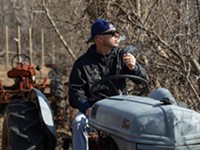
These small cannabis farmers say New York's legal weed rollout is ruining their lives
Mar 21, 2024 -

Man shakes fist at sun
Mar 15, 2024 - More »
